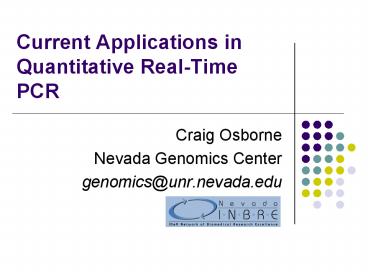Current Applications in Quantitative RealTime PCR PowerPoint PPT Presentation
1 / 14
Title: Current Applications in Quantitative RealTime PCR
1
Current Applications in Quantitative Real-Time PCR
- Craig Osborne
- Nevada Genomics Center
- genomics_at_unr.nevada.edu
2
Starting Materials
- Structural Assay
- Uses DNA, typically genomic extractions
- Single Nucleotide Polymorphism
- Functional Assay
- Uses RNA extractions
- Uses reverse transcriptase to generate cDNA
templates - Differential expression
- Diagnostics involving gene expression
- RNA interference
3
RT-PCR Chemistries
- 5 exonuclease
- TaqMan
- Requires primers and labeled probe specific to
gene - Intercalation
- SYBR Green
- Requires primers specific gene
- Labeled Primer
- Light Upon Extension (LUX)
- Requires labeled primer that contains a hairpin
loop
4
5 Exonuclease
5
5 Exonuclease
- Advantage
- Probe is specific to template
- Disadvantage
- Cost
- Probe degradation
6
Intercalation
- SYBR Green
- Binds to minor groove of double stranded DNA
- Can only be fluoresced when bound
- Advantage
- Low cost
- Disadvantage
- Binds to all dsDNA in the reaction
7
Quantitation Strategies
- Absolute quantitation Unknown samples are
compared to a standard curve. The standard is a
known DNA sample whose concentration is known
absolutely. The accuracy of the absolute
quantitation assay is entirely dependent on the
accuracy of the standards. - Relative quantitation A comparison within a
sample (DNA or cDNA) is made with the gene(s) of
interest to that of an endogenous control gene.
Quantitation is done relative to the control gene.
8
Common Uses
- Microarray/Differential Expression
- RNAi
- Diagnostics
- SNP Genotyping
9
Differential Expression
- Compares transcriptional levels of genes between
control and experimental samples - Endogenous controls are used to normalize the
data - Endogenous controls are genes common to both
control and experimental samples that do not
change their expression levels under the
experimental conditions - GAPDH
- ß-Actin
- 18s ribosomal subunit
10
Threshold Cycle
- As the PCR progresses into the exponential phase,
the system detects a cycle when the fluorescence
detected is significantly higher than the
baseline value. - Threshold cycle (Ct) point at which the
fluorescent signal is first recorded as
statistically significant above background - The Ct value of each RT-PCR reaction depends on
the initial template amount (copy number) of the
target sequence, and it is inversely proportional
to the log of this copy number. - The more templates present at the beginning of
the reaction, the fewer number of cycles it takes
to reach Ct. - Real-time PCR now makes quantitation of DNA and
RNA much more precise and reproducible because it
relies on Ct values determined during the
exponential phase of PCR rather then endpoint.
11
Comparing Ct Values
12
RNAi
- RNA interference double stranded RNA (siRNA)
forms a complex (RISC) that binds to target mRNA
and leads to its degradation
13
Diagnostics
- Use a panel of genes representative of conditions
in question - Presence of certain genes in the panel can be
used to identify specific conditions
14
SNP
- Single Nucleotide Polymorphisms
- Allelic Discrimination Assays
- Genomic locus where two or more alternative bases
occur with appreciable frequency

